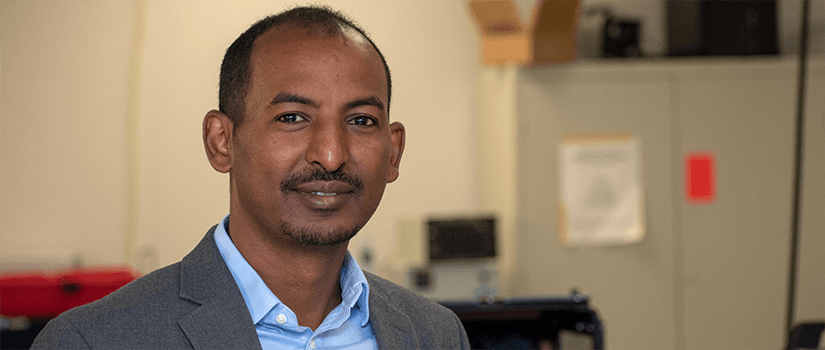By Abe Danaher | November 25, 2019
Through a three-year grant from the United States Army, Addis Kidane is looking to decrease the weight and improve the safety of military equipment by researching shock mitigation and impact loading through optimized cellular materials.
Kidane, an associate professor at the University of South Carolina College of Engineering and Computing, is studying how cellular materials behave when exposed to high rate loading conditions, such as the force of an IED exploding just feet away. He is considering multiple factors – such as cell size and geometry – to optimize a foam material and maximize its absorption of energy.
To do so, he is using digital image correlation (DIC) measurement technology originally developed in the College of Engineering and Computing to measure the strain distribution on a piece of foam as a projectile is launched into it. The DIC method captures how all of the foam compresses when hit by the projectile. Along with the measured time-varying load, the results allow Kidane to compare the energy absorption of different foams under the same impact circumstances.
“Professor Kidane’s work will help determine the mechanics responsible for failure initiation and propagation in cellular materials used in energy absorption systems,” said Denise Ford, a program manager of solid mechanics within the Army Research Office which is an element of the U.S. Army Combat Capabilities Development Command’s Army Research laboratory. “This research could lead to improved protections for soldiers, vehicles and equipment against impact or blast events.”
Kidane’s research team is in the third stage of the project. First, they designed and conducted experiments to understand the foam material better. Then, based on these experiments, they developed a numerical model to predict how the material would fail under high-stress situations. Now, they are designing the optimal foam.
He believes that the impact of this project’s findings will extend beyond military equipment. Kidane says, “In the broader community, this concept can be adapted and used for many applications, including sports shoes, helmets, automotive parts, dental, knee and hip replacements.”
Once the project is complete in November 2020, his findings will be adapted by the Army and used to design body armor plates, vests, helmets, automotive parts and much more. This fits into a larger effort by the military to create lighter, safer materials for soldiers.
“If you can reduce weight while still maintaining protection of the people inside the vehicles, then you save an incredible amount of fuel and decrease the energy requirements needed to move people from one place to another in the modern battlefield,” says Michael Sutton, a distinguished professor who has helped advise the research project. “I think that’s a major part of this. Can they take foam and combine it with other materials – front plates, back plates – to make something lighter that still protects people.”
